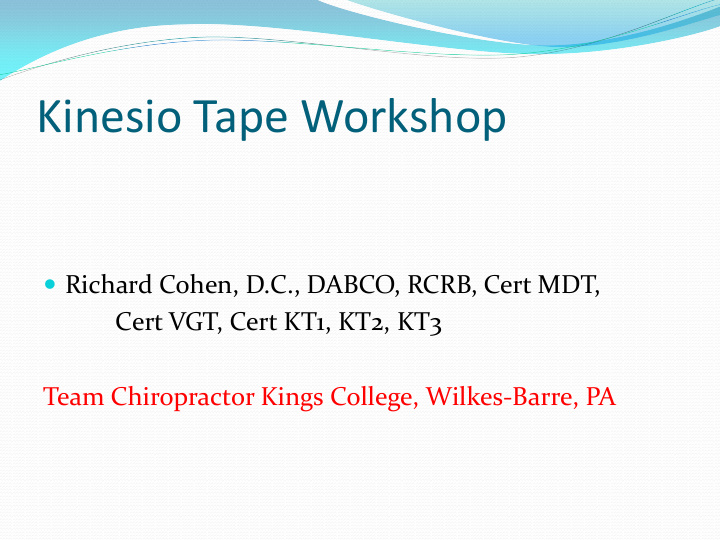



Kinesio Tape Workshop Richard Cohen, D.C., DABCO, RCRB, Cert MDT, Cert VGT, Cert KT1, KT2, KT3 Team Chiropractor Kings College, Wilkes-Barre, PA
History Concept developed by Kenzo Kase in the 70’s Introduced to NATA in USA 1995 Introduced to the Rehab community in 1997 Medicare coding in 2001
Properties of Tape Thickness and elasticity of skin Elastic to 40% greater than resting length Tape replicates hands on touch Effective for up to 5 days of use
Properties of Tape Acrylic adhesive in a wave like pattern Latex free Heat activated adhesive increase adhesion
Types of Tape Kinesio Tape- Kenzo Kase’s tape Precut and rolls 40% stretch Spider Tech- Kinesiology Tape Developed in Japan 1987- precut and rolls KT Tape- Dick’s K- Active Tape Rock Tape More cloth, more elastic, more adhesive 90% stretch Don’t offer pre -cut due to variable sized individuals
Benefits of Kinesio Tape Purpose- Improve circulation Support muscles Improve healing Protect against re-injury
Benefits of Kinesio Tape Versus traditional athletic tape- Allows freedom of movement which stimulates neural response Allows flow of fluids to improve the healing process
Benefits of Tape Analgesic effect- Stimulation of mechanoreceptors Stimulate interfascial nerves to reduce tone
Benefits of Tape Proprioceptive stimulation Sensory feedback to reduce or enhance ROM Reduced inflammation- Lift tissue and reduce interfascial congestion Lymphatic drainage Reduced tone in interfascial nerves reduces autonomic response of blood vessels to decrease congestion
Benefits of Tape Correct joint position and provide stability Pressure into joint to stimulate mechanoceptors Positional facilitation Reduce adhesions and scarring Application along scar
Types of Application Y I X Fan/Web Star
Y applications Used to surround muscles Useful to facilitate or inhibit muscles Applied longer than target muscle
I application Used for more acute injuries in place of a Y Covers a greater surface area so more useful for pain and swelling Used for alignment correction
X application Useful for muscles with broad attachment areas such as the Rhomboid group
Fan application Useful for edema and lymphatic drainage
Types of Application Stretch of tape- percent refers to amount of available stretch Full- 100% Severe- 75% Moderate- 50% Light- 15-25% Tape on paper is prestretched 10% Less is better
Types of Application Muscle Facilitation- Put muscle on stretch Origin to insertion???????? Useful for acute or chronically weak muscles 10-25% stretch
Types of Application Muscle Relaxation- Put muscle on stretch useful for overused/overactive muscles Insertion to origin???????? 0-10% stretch Rebound of proprioceptive feedback in direction opposite contraction???????
Types of Application Principles for swelling reduction Tape over edematous area Direction is not significant Fan shape is most common 0-10% stretch
Edema Control
Types of Application Joint function correction and pain control Adjust misalignment caused by spasm and tone Normalizes muscle tone and fascial abnormalities Improves ROM Relieves pain Proprioceptive re-education 50-100% stretch AKA Space Correction
Space Correction Plus
Application Guidelines Remove hair- hand held shaver No oils or lotions Pat dry if wet Alcohol can prep oily skin
Application Guidelines Measure appropriate length- allow for desired stretch Round edges Avoid touching adhesive and handling tape excessively Rub tape after application to increase adherence
Practice 1. Inversion ankle sprain A. Correction for ATF and subtalar joints B. Lateral ankle swelling- fan or star C. Facilitation for peroneii and tib post
Practice 2. Plantar Fascitis A. Plantar muscle facilitation B. Arch Correction
Practice 3. Patello-femoral dysfunction/Tendonosi s/itis A. Inferior tendon correction B. Patellar glide correction C. Quadriceps facilitation
Practice 4. Lateral Epicondylitis A. Relax extensor group B. Relax distal triceps C. Pain control over epicondyle
Practice 5. Thumb sprain A. Thenar muscle facilitation B. Wrist correction C. Extensor group facilitation D. Carpal/metacarpal correction
Practice 6. Rotator Cuff Syndrome/Complex Muscles Rotator cuff muscles Deltoids Biceps/Triceps Joints AC GH
Practice 7. Spine Lumbar spine Thoracic spine Cervical spine Fascial/muscular Joint
Thank you Richard Cohen, D.C. Board Certified Chiropractic Orthopedist Certified Chiropractic Sports Physician Board Eligible Chiropractic Rehab Specialist Cert MDT (Mechanical Diagnosis and Therapy) Cert Vojta Therapist Cert. Kinesio Practitioner K1, K2, K3 417 Market St. Kingston, PA 18704 570-262-9374 richcohendc@hotmail.com
Recommend
More recommend